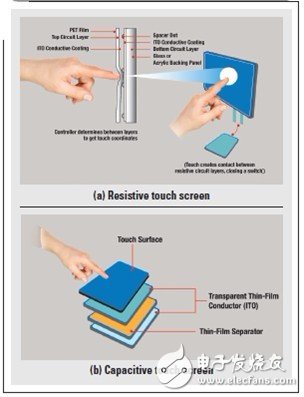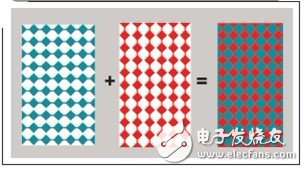introduction
Resistive touch screens have had their heyday, but it is undeniable that they have faded. Obviously, it is more suitable for low-cost design. Users using these designs must wear gloves, for example: in medical, industrial and military environments. However, capacitive touch screens have gained widespread use, and mainstream smartphones and tablets sold on the market today use capacitive touch screens.
Comparison of resistive and capacitive touch screens
Both resistive and capacitive touch screens use indium tin oxide (ITO) sensors, but they are used in very different ways. The resistive touch screen uses the mechanical force of human touch to connect the two flexible layers of ITO (Figure 1a), while the capacitive touch screen control uses: basically, the person itself is a moving capacitor. Touching ITO changes the capacitance level that the system can perceive (Figure 1b).

Figure 1 Comparison of touch screen design
Capacitive touch screens are favored by consumers for two main reasons:
1. The capacitive touch screen uses two layers of TIO, sometimes one layer. It uses a textured sensor similar to a checkerboard (Figure 2), so it can be covered on the LCD with a whole piece, resulting in a clearer and translucent screen.
2. Since the capacitive touch screen control uses the electrolytic capacitor method to achieve detection, the safety glass layer can be placed on the top layer to achieve sealing, which is different from the polyurethane flexible layer of the resistive screen. It also brings a more durable design to users.

Figure 2 TIO rows and columns overlap to form a complete sensor sheet
Capacitive touch screen design considerations
The designers of capacitive touch screens face three main problems: power consumption, noise control and gesture recognition. The rest of this article will explain you one by one.
Power consumption
With so many battery-powered devices today, power consumption is one of the key system issues we need to consider. Devices such as TI's TSC3060 are designed according to low power consumption requirements. Under standard operating conditions, its power consumption is less than 60mA. When detecting touch behavior, its power consumption can be as low as 11 µA. In the same working state, it is at least an order of magnitude lower than its competitors.
Many solutions on the market were originally designed as microcontrollers, and then gradually developed into capacitive touch screen controllers. Designed as a capacitive touchscreen controller from the beginning, there is no extra hardware that consumes extra current and clock cycles. Most systems already have a main central processor, which can be a digital signal processor, a microprocessor, or a microcontroller unit (MCU). So why add another engine to a system that has been fine-tuned? TSC3060 is a special design without a microcontroller.
Noise control
If the controller is unable to distinguish between actual touch and potential sources of interference, not to mention the long battery life. The main noise source of the touch screen usually comes from the LCD, which ultimately depends on the trade-off between quality and cost. AC public ground LCDs are generally cheaper, but have higher noise levels. The DC common ground LCD has DC shielding, which can reduce noise, but will increase costs.
A typical method that can help reduce the amount of noise that the ITO sensor and touch screen controller can perceive is to maintain a certain air gap between the LCD and ITO. This can leave a certain distance between the two, thereby reducing mutual interference. Another way to deal with noise is to use filters. For example, TSC3060 contains a set of programmable mixed signal filters that can be used to reduce noise. These filters are installed into the hardware via an integrated MCU. This means that they can complete tasks nearby faster than using software filters. Quick response to actual touch coordinates can also reduce total system resource consumption.
Gesture Recognition
The last design issue is gesture recognition. Gestures are not necessarily large, complex waves. The gesture can be a simple finger swipe. The system host MCU can easily recognize some simple gestures, such as: pinch, pull, zoom, rotate, double-click and triple combo, etc., and can perform "internal" processing. Adding a dedicated engine may reduce the system MCU bandwidth processing load a little, but it will increase power consumption. In addition, the dedicated engine is used to complete the proprietary algorithm of gesture recognition, which designers cannot see. TSC3060 and other devices push this kind of work to the existing main processor in the system, allowing designers to develop their own royalty-free algorithms freely.
in conclusion
This article compares the functions and advantages of resistive and capacitive touch screen controllers, and explains why the latter is becoming more popular. The article also introduces the reader to the three main considerations when designing a touch screen controller, namely power consumption, noise control and gesture recognition, and gives some possible solutions.
What is 5G CPE?
Definition of 5G CPE
CPE stands for Customer Premise Equipment. The so-called front end refers to the equipment in front of the customer's terminal equipment. When we use Wi-Fi, if the distance is far, or there are more rooms, it is easy to appear signal blind spots, resulting in mobile phones or ipads or computers can not receive Wi-Fi signals. The CPE can relay the Wi-Fi signal twice to extend the coverage of Wi-Fi.
What are the benefits of CPE?
Through the following comparison table, it is not difficult to understand the technical advantages of CPE products:
* Currently, the global 5G FWA service is mainly in the Sub-6GHz band, with only the United States and Italy supporting the millimeter wave band.
* 5G CPE integrates the low cost of Wi-Fi and the large bandwidth of 5G, combining the advantages of the two to form a strong complement to traditional fiber broadband.
The relationship between 5G, FWA and CPE
It can be said that FWA (Fixed Wireless Access) will be the most down-to-earth application of 5G technology. FWA business plays a key role in enabling "connecting the unconnected." FWA is a low-cost, easy-to-deploy flexible broadband solution. Compared with wired access technology, FWA has been an ideal choice for deploying broadband in many countries and regions because it does not need to obtain rights of way, dig trenches and bury cables, and drill holes through walls. The development of 5G technology is further promoting the development of FWA.
FWA services (including 4G and 5G) have reached 100 million users. FWA is no longer a niche service; The FWA industry as a whole has been supported by numerous suppliers. Why is that? In the 5G era, 5G CPE receives 5G signals from operator base stations and then converts them into Wi-Fi signals or wired signals to allow more local devices to get online. For operators, the initial user penetration rate of 5G is low, and the investment is difficult to realize quickly; The CPE business can use the idle network to increase revenue for operators, so major operators vigorously promote the development of 5G CPE.
FWA services can be used for both home (To C) and business (To B), and customers have different requirements for CPE devices when using FWA services in different application environments, resulting in consumer grade 5G CPE and industrial grade 5G CPE (similar to home routers and industrial routers).
In 2020, the global market size of 5G CPE will reach 3 million units, and it is expected that in the next five years, the market size of 5G CPE will maintain a compound growth rate of more than 100%, reaching 120 million units in 2025, with a market value of 60 billion yuan. As an important market for 5G CPE, China's 5G CPE market size will reach 1.5 million units in 2020 and is expected to reach 80 million units in 2025, with a market value of 27 billion yuan.
The difference between 5G CPE and other devices
CPE can support a large number of mobile terminals that access the Internet at the same time, and the device can be directly inserted with a SIM card to receive mobile signals. CPE can be widely used in rural areas, cities, hospitals, units, factories, communities and other wireless network access, can save the cost of laying wired networks.
A Router is a hardware device that connects two or more networks, acts as a gateway between networks, and is the main node device of the Internet. Routers use routes to determine the forwarding of data. If it is a home router, it does not support a SIM card slot, and can only receive signals by connecting to optical fiber or cable and then convert it into WI-FI to provide a certain number (several) of terminal devices to surf the Internet.
Industrial 5G CPE is equivalent to 5G industrial routers, and the technology of the two is not very different. On the one hand, the industrial 5G CPE converts 5G network signals into WiFi signals for transmission, and on the other hand, the data received by the WiFi network is converted into 5G network signals for uploading. In addition, industrial 5G CPE generally supports routing functions.
5G CPE trends
According to a research report, after evaluating the products of some mainstream 5G CPE suppliers, many institutions believe that the development of 5G CPE products will continue in two aspects: one is to support mmWave and Sub-6 GHz at the same time; Second, the design will pay attention to humanized operation and installation. The industry development trend will accelerate the demand for 5G in the medical, education and manufacturing industries due to the epidemic, and 5G FWA will promote global 5G CPE shipments.
Wireless Cpe,4G Cat6 Cpe,Mifi 4G,Ufi 4G
Shenzhen MovingComm Technology Co., Ltd. , https://www.mcrouters.com